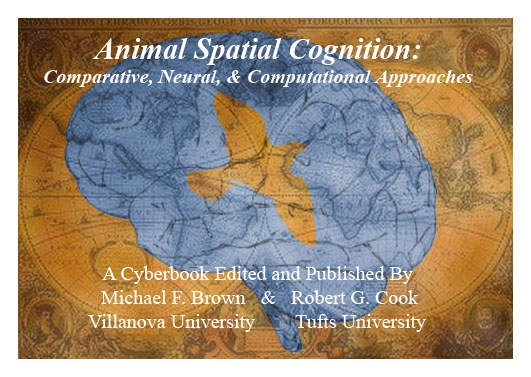What Would Tolman Think?
Space and CyberspaceMichael F. Brown & Robert G. Cook
Villanova University & Tufts University
Edward Chace Tolman, 1886-1959
Professor of Psychology, UC Berkeley
Photograph by Dorothy Moore, circa 1936
University of California Archives
The Bancroft LibraryWhen we were graduate students in Al Riley's lab at the University of California, we conducted a series of experiments using radial-arm mazes and aimed at illuminating the contents of spatial working memory. Appropriately enough, the building that housed the Psychology Department had been named Tolman Hall in 1963. In the lobby of the building, a large portrait of Tolman dominated the space. He was perceived as an imposing figure by most of the graduate students in the department, but we felt that Professor Tolman was watching over us as we waited for the elevator on our way back and forth to the lab. We wondered what he would have thought about the work we were doing, involving as it did rats in mazes and theoretical notions about how the spatial world was represented inside the animal. Our own work has gone in various directions since then, but Tolman's influence on the fundamental theoretical framework brought to bear on psychological questions remains as strong as ever, not just in our work and not just in the area represented by this book, but in the field of comparative cognition generally (Riley, Brown & Yoerg, 1986; Zentall, 1993). Among Tolman's best known work, of course, was that involving what is now referred to as spatial cognition -- the topic at the heart of this cyberbook.
This is the second cyberbook to be published under the auspices of the Comparative Cognition Press. The purpose of these cyberbooks is to bring together descriptions of the latest empirical research and theoretical ideas in selected topics of comparative cognition. Together with Comparative Cognition and Behavior Reviews (the web-based journal published by the Comparative Cognition Press) and the Proceedings of the International Conference on Comparative Cognition, these publications are the Comparative Cognition Society's efforts to bring the exciting and important science of animal cognition to as wide and large an audience as possible and to provide a model for how the internet can be used to present the products of science in ways that take advantage of its dynamic visual and auditory format.
The first cyberbook in the series - Avian Visual Cognition - was edited by Robert Cook and published in late 2001. Since then, that cyberbook has received over 500,000 separate visits from users from over 80 countries. In total, over 1,100,000 pages of the book have been hit (and presumably viewed). On average, each individual chapter has been hit nearly 20,000 times. Further, the number of hits per month have steadily increased over the five years, with the book being accessed more now than ever. These numbers indicate that the cyberbook format reaches many more people than traditionally printed scholarly volumes. Because of its ready availability it has been widely used in classrooms around the country. Our field, in which the most common measurements are the behaviors of animals, is particularly well suited to take advantage of internet-based presentation. The most interesting and important aspects of our data include the movements, choices, displays, and sounds of the animals we study. These data and and the procedures used to collect them can be illustrated directly in a cyberbook. Many examples can be found on the pages of this and the previous book in the series.
Spatial cognition has been and continues to be among the core areas of interest in the study of animal cognition and behavior. Psychologists engaged in the study of animal behavior have concentrated on the mechanisms by which animals respond to the causal relations between their behavior and its outcomes (instrumental conditioning) and among events in the environment (classical conditioning). More recently, the mechanisms involved in the control of behavior by temporal relations have also received extensive empirical and theoretical attention. In addition to causal and temporal relations, spatial relations form a critical part of the environment in which all animals live. They control behavior in important ways. Tolman's (1948) proposal that spatial behavior could be usefully explained in terms of cognitive representations of spatial relations among places and objects in the world marks the beginning of this approach. Its influence was substantially increased when O'Keefe and Nadel (1976) provided a convincing argument that such representations had a clear basis in neurophysiology.
Today, the scope and depth of research on spatial navigation and spatial memory is expansive, with work being done on natural behavior in the field, laboratory experiments intended to elucidate general principles, refined quantitative models of spatial behavior, and a variety of research on the neurophysiological mechanisms of spatial cognition. Work being done by cognitive psychologists using human participants parallels many of the issues and methodologies being used to study animal spatial cognition. Spatial cognition is one of the key areas of investigation in psychology where all of these approaches have been actively and successfully pursued and increasingly integrated. The goal of this volume is that by bringing together investigators using all of these approaches, we can facilitate the level of integration among the many perspectives on spatial cognition.
The first two chapters of this cyberbook represent a strongly comparative approach to understanding animal cognition. Balda and Kamil summarize their important studies comparing spatial cognition in closely related species. Their work is a model of how comparisons of the psychology of species filling different ecological niches can guide our understanding of the underlying cognitive processes. The arguments for this approach are made explicit by Healy, describes examples of how consideration of the adaptive function of cognition provides a rich source of hypotheses about the particulars of the cognitive and biological mechanisms.
The importance of traditional behavioral experimentation using non-human and human subjects in laboratory paradigms is illustrated by the next three chapters of the volume. Brown reviews a line of research showing that representations of abstract spatial patterns can be demonstrated in rats. Cheng and Newcombe's chapter also describes an important line of research that relies on a laboratory paradigm that has been very important for the development of ideas about the nature of spatial representation. They review work on Cheng's geometric representation using a wide variety of species, including human children. Taylor and Rapp describe an example of the work being done in human spatial cognition laboratories. There are many parallels in the ideas and findings from these two research traditions.
The behavioral neuroscience approach to understanding spatial cognition is well represented by the next three chapters. Bingman, Jechura, and Kahn review their extensive experimental analyses of the navigational cues involved in long-range navigation in homing pigeons and the underlying role of the avian hippocampus. Mizumori and Smith describe how it can be shown that specific cells in rat hippocampus code locations in space and how neural systems can be seen as interacting to determine spatial behavior. Phillips, Schmidt-Koenig, and Muheim argue that very different cues may be used for navigation at different scales and that, at larger spatial scales, geomagnetic dues may be more important for a wider range of species than has been appreciated.
The elegance and sophistication with which spatial behavior and spatial cognition can be formally modeled is represented by the last two chapters of the cyberbook. Biegler examines some of the formal properties and requirements for using information provided by different kinds of spatial representations. Schmajuk and Voicu argue that some of the inherent complexities of spatial navigation can be understood if the maps used by the representational system are structured hierarchically.
These ten contributions provide an excellent perspective of the landscape of the comparative analysis of spatial cognition. There are many important points of contact among these various approaches, but there is the potential for many more. We hope the researchers and students reading these chapters will begin to take on these challenges and opportunities. By presenting these approaches together in and easily accessible and readily available cyberformat, our goal is to facilitate and accelerate this future integration of the comparative, behavioral, neurobiological, and computational approaches to understanding spatial cognition in human and non-human animals.
We hope that Professor Tolman would have been pleased.
November, 2006
Acknowledgements
We are very grateful to the many individuals and organizations who helped make this project possible. Tufts and Villanova Universities provided material support that allowed us to work on the project. Support provided to each of our laboratories by the National Science Foundation also facilitated the project. Technical advice and assistance during the early part of the project was provided by Joan Lesovitz and Jonathan Connolly of Villanova's Center for Instructional Technology. Many Villanova and Tufts students provided feedback on draft versions of the chapters and technical assistance, including Kelly DiGian, Edward Lorek, Hara Rosen, Madeline Weiss, Jessie Horowitz, and Caitrin Eaton. We want to especially thank Tufts student Emily O'Neil, whose hard work and excellent Frontpage skills got us through the final phases of production. Thanks most of all to the contributing authors of this cyberbook. Everyone worked hard to provide us with excellent contributions that take advantage of the electronic format. We appreciate the trust that the contributors had in us to produce the cyberbook and the patience that was sometimes required to see the project through to completion.
References
O‘Keefe, J., & Nadel, L. (1978). The hippocampus as a cognitive map. Oxford: Oxford University Press.
Riley, D.A., Brown, M.F., & Yoerg, S.I. (1986). Understanding animal cognition. In T.J. Knapp & L.C. Robertson (Eds.) Approaches to cognition: Contrasts and controversies (pp. 111-136). Hillsdale, N.J.: Erlbaum.
Tolman, E.C. (1948). Cognitive maps in rats and men. Psychological Review, 55, 189-208.
Zentall, T.R. (1993). Animal cognition: An approach to the study of animal behavior. In T. R. Zentall (Ed.) Animal cognition: Essays in Honor of Donald A. Riley (pp. 3-15). Hillsdale, NJ: Erlbaum.


